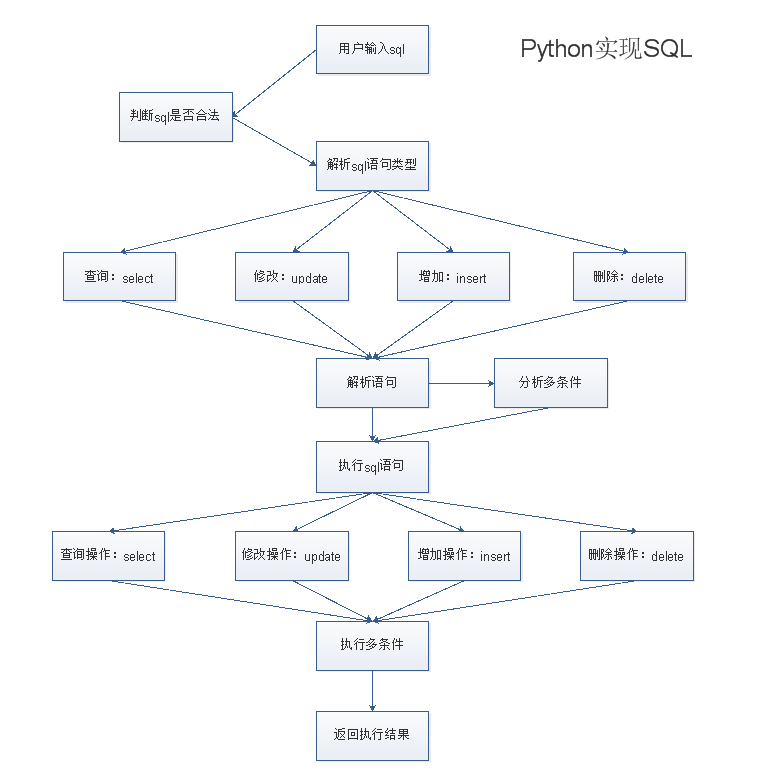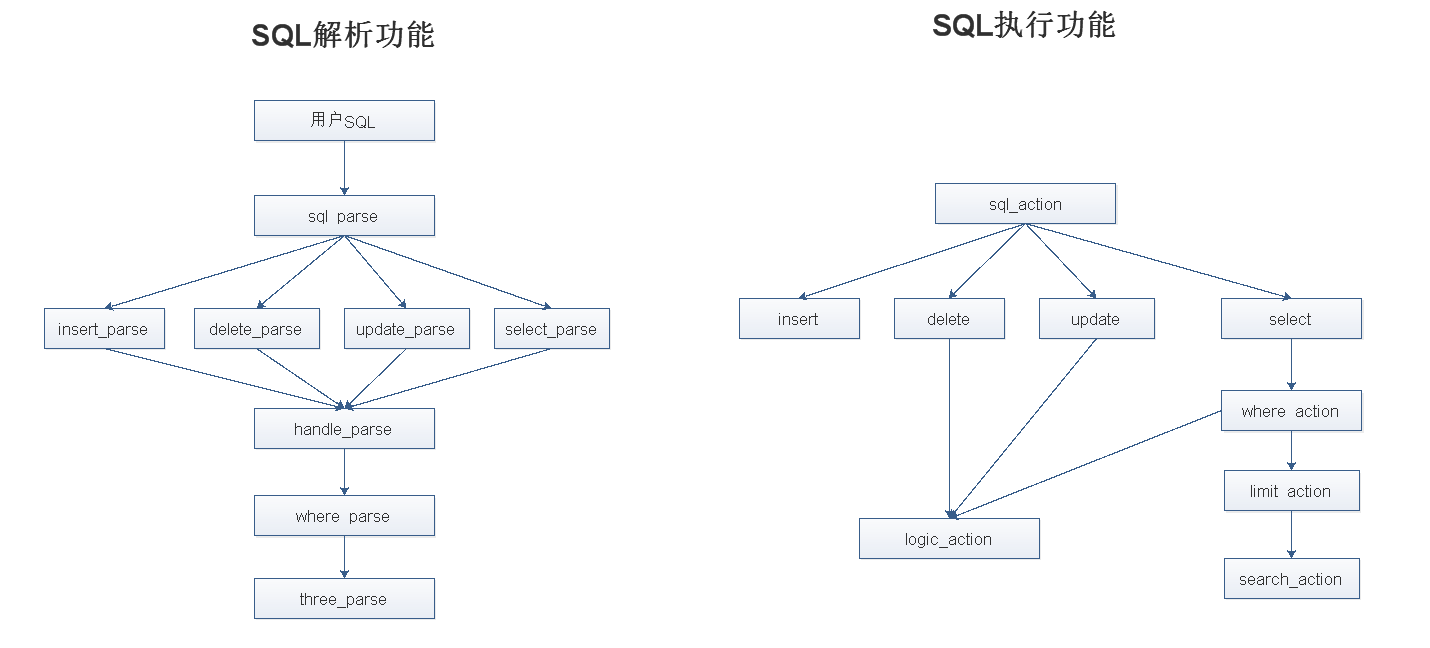Python操作文件模拟SQL语句功能
2018-01-03 19:26
393 查看
一、要求
当然此表你在文件存储时可以这样表示1,li,22,18230393840,IT,2013-06-01 现需要对这个员工信息文件,实现增删改查操作1. 可进行模糊查询,语法至少支持下面3种: 1. select name,age from staff_table where age > 22 2. select * from staff_table where dept = "IT" 3. select * from staff_table where enroll_date like "2013“ 2. 可修改员工信息,语法如下: 1. UPDATE staff_table SET dept="Market" WHERE where dept = "IT"注意:以上需求,要充分使用函数,请尽你的最大限度来减少重复代码!
二、实现流程
第一部分:SQL解析
1.接收用户SQL判断用户输入是否为SQL
2.SQL解析主函数sql_parse
where_parse
three_parse
insert_parse
delete_parse
update_parse
select_parse
分发SQL给对应语句的函数来做解析
解析后交给handle_parse,来控制返回
解析SQL语句中的多条件
返回解析后的SQL
第二部分:SQL执行
1.接收解析后的SQL2.SQL执行主函数sql_action
where_action
logic_action
limit_action
search_action
insert
delete
update
select
分发SQL给对应函数来执行
执行SQL语句时的多条件
返回执行SQL的结果
三、图解


代码:
#/usr/local/env python
#_*_coding:utf-8_*_
#第一部分:sql解析
import os
def sql_parse(sql): #用户输入sql 转成结构化的字典
'''
第一步:sql解析 流程
1.收到 sql查询条件
2.sql_parse 来分发要求给 select_parse
3.select_parse 调用 handle_parse 解析sql
4.handle_parse 返回解析sql后的结果 sql_dic 给 select_parse
5.select_parse 把 sql_dic 返回给sql_parse
sql_dic=sql_parse(sql) #用户输入sql 转成结构化的字典sql_dic
sql语句四种操作格式:insert delete update select
提取用户输入sql 的操作关键词 再进行分析和分发操作
把sql字符串切分,提取命令信息,分发给具体解析函数去解析
:param sql:用户输入的字符串
:return:返回字典格式sql解析结果
'''
#sql命令操作 解析函数的字典 根据用户的命令来找相对应的函数
parse_func={
'insert':insert_parse,
'delete':delete_parse,
'update':update_parse,
'select':select_parse,
}
#print('用户输入 sql str is : %s' %sql) #打印用户输入的sql
sql_l=sql.split(' ') #按空格切割用户sql 成列表 方便提取命令信息
func=sql_l[0] #取出用户的sql命令
#判断用户输入的sql命令 是否在定义好的sql命令函数的字典里面,如果不在字典里面,则返回空
res=''
if func in parse_func:
res=parse_func[func](sql_l) #把切割后的 用户sql的列表 传入对应的sql命令函数里
return res
def insert_parse(sql_l):
'''
定义insert语句的语法结构,执行sql解析操作,返回sql_dic
:param sql:sql按照空格分割的列表
:return:返回字典格式的sql解析结果
'''
sql_dic={
'func':insert, #函数名
'insert':[], #insert选项,留出扩展
'into':[], #表名
'values':[], #值
}
return handle_parse(sql_l,sql_dic)
def delete_parse(sql_l):
'''
定义delete语句的语法结构,执行sql解析操作,返回sql_dic
:param sql:sql按照空格分割的列表
:return:返回字典格式的sql解析结果
'''
sql_dic = {
'func': delete,
'delete': [], # delete选项,留出扩展
'from': [], # 表名
'where': [], # filter条件
}
return handle_parse(sql_l, sql_dic)
def update_parse(sql_l):
'''
定义update语句的语法结构,执行sql解析操作,返回sql_dic
:param sql:sql按照空格分割的列表
:return:返回字典格式的sql解析结果
'''
sql_dic = {
'func': update,
'update': [], # update选项,留出扩展
'set': [], # 修改的值
'where': [], # filter条件
}
return handle_parse(sql_l, sql_dic)
def select_parse(sql_l):
'''
定义select语句的语法结构,执行sql解析操作,返回sql_dic
:param sql:sql按照空格分割的列表
:return:返回字典格式的sql解析结果
'''
# print('from in the select_parse :\033[42;1m%s\033[0m' %sql_l)
# select语句多种条件查询,列成字典,不同条件不同列表
sql_dic={
'func':select, #执行select语句
'select':[], #查询字段
'from':[], #数据库.表
'where':[], #filter条件,怎么找
'limit':[], #limit条件,限制
}
return handle_parse(sql_l,sql_dic)
def handle_parse(sql_l,sql_dic): #专门做sql解析操作
'''
执行sql解析操作,返回sql_dic
:param sql_l: sql按照空格分割的列表
:param sql_dic: 待填充的字典
:return: 返回字典格式的sql解析结果
'''
# print('sql_l is \033[41;1m%s\033[0m \nsql_dic is \033[41;1m%s\033[0m' %(sql_l,sql_dic))
tag=False #设置警报 默认是关闭False
for item in sql_l: #循环 按空格切割用户sql的列表
if tag and item in sql_dic: #判断警报拉响是True 并且用户sql的条件 在条件select语句字典里面,则关闭警报
tag=False #关闭警报
if not tag and item in sql_dic: #判断警报没有拉响 并且用户sql的条件 在条件select语句字典里面
tag=True #拉响警报
key=item #取出用户sql的条件
continue #跳出本次判断
if tag: #判断报警拉响
sql_dic[key].append(item) #把取出的用户sql 添加到 select语句多种条件对应的字典里
if sql_dic.get('where'): #判断 用户sql where语句
sql_dic['where']=where_parse(sql_dic.get('where')) #['id>4','and','id<10'] #调用where_parse函数 把整理好的用户sql的where语句 覆盖之前没整理好的
# print('from in the handle_parse sql_dic is \033[43;1m%s\033[0m' %sql_dic)
return sql_dic #返回 解析好的 用户sql 字典
def where_parse(where_l): #['id>','4','and','id','<10'] ---> #['id>4','and','id<10']
'''
分析用户sql where的各种条件,再拼成合理的条件字符串
:param where_l:用户输入where后对应的过滤条件列表
:return:
'''
res=[] #存放最后整理好条件的列表
key=['and','or','not'] #逻辑运算符
char='' #存放拼接时的字符串
for i in where_l: #循环用户sql
if len(i) == 0 :continue #判断 长度是0 就继续循环
if i in key:
#i为key当中存放的逻辑运算符
if len(char) != 0: #必须 char的长度大于0
char=three_parse(char) #把char字符串 转成列表的形式
res.append(char) #把之前char的字符串,加入res #char='id>4'--->char=['id','>','4']
res.append(i) #把用户sql 的逻辑运算符 加入res
char='' #清空 char ,为了下次加入char到res时 数据不重复
else:
char+=i #'id>4' #除了逻辑运算符,都加入char #char='id<10'--->char=['id','>','4']
else:
char = three_parse(char) # 把char字符串 转成列表的形式
res.append(char) #循环完成后 char里面有数据 ,再加入到res里面
# ['id>4','and','id<10'] ---> #['id','>','4','and','id','<','10']
# print('from in the where_parse res is \033[43;1m%s\033[0m' % res)
return res #返回整理好的 where语句列表
def three_parse(exp_str): # 把where_parse函数里面 char的字符串 转成字典
'''
将每一个小的过滤条件如,name>=1转换成['name','>=','1']
:param exp_str:条件表达式的字符串形式,例如'name>=1'
:return:
'''
key=['>','<','='] #区分运算符
res=[] #定义空列表 存放最终值
char='' #拼接 值的字符串
opt='' #拼接 运算符
tag=False #定义警报
for i in exp_str: #循环 字符串和运算符
if i in key: #判断 当是运算符时
tag=True #拉响警报
if len(char) != 0: #判断char的长度不等于0时(方便添加连续运算符)才做列表添加
res.append(char) #把拼接的字符串加入 res列表
char='' #清空char 使下次循环不重复添加数据到res列表
opt+=i #把循环的运算符加入opt
if not tag: #判断 警报没有拉响
char+=i #把循环的字符串加入 char
if tag and i not in key: #判断 警报拉响(表示上次循环到运算符),并且本次循环的不是运算符
tag=False #关闭警报
res.append(opt) #把opt里面的运算符 加入res列表
opt='' #清空opt 使下次循环不重复添加数据到res列表
char+=i #把循环到的 字符串加入char
else:
res.append(char) #循环结束,把最后char的字符串加入res列表
#新增解析 like的功能
if len(res) == 1: #判断 ['namelike李'] 是个整体
res=res[0].split('like') #以like切分字符串
res.insert(1,'like') #加入like字符串,因为上面切分的时候剔除了like
# print('three_parse res is \033[43;1m%s\033[0m' % res)
return res #返回res列表结果
#第二部分:sql执行
def sql_action(sql_dic): #接收用户输入的sql 的结构化的字典 然后执行sql
'''
从字典sql_dic提取命令,分发给具体的命令执行函数去执行
执行sql的统一接口,内部执行细节对用户完全透明
:param sql_dic:
:return:
'''
return sql_dic.get('func')(sql_dic) #接收用户sql,分发sql,执行命令
def insert(sql_dic):
print('insert %s' %sql_dic)
db,table=sql_dic.get('into')[0].split('.') #切分文件路径,相对应数据库,表
with open('%s/%s' %(db,table),'ab+') as fh: #安装上面的路径 打开文件 ab+模式
# 读出文件最后一行,赋值给last 配合+
offs = -100 #
while True:
fh.seek(offs,2)
lines = fh.readlines()
if len(lines)>1:
last = lines[-1]
break
offs *= 2
last=last.decode(encoding='utf-8')
last_id=int(last.split(',')[0]) #取出最后一行id号
new_id=last_id+1 #id号加1 实现id自增效果
#insert into db1.emp values alex,30,18500841678,运维,2007-8-1
record=sql_dic.get('values')[0].split(',') #提取用户想要 添加的sql
record.insert(0,str(new_id)) #加入自增后的id 到用户sql的头部
#['26','alex','35','13910015353','运维','2005 - 06 - 27\n']
record_str=','.join(record)+'\n' #把用户sql列表切成字符串
fh.write(bytes(record_str,encoding='utf-8')) #把添加 id后的用户想添加的sql 用bytes写入文件
fh.flush()
return [['insert successful']]
def delete(sql_dic):
db,table=sql_dic.get('from')[0].split('.')
bak_file=table+'_bak'
with open("%s/%s" %(db,table),'r',encoding='utf-8') as r_file,\
open('%s/%s' %(db,bak_file),'w',encoding='utf-8') as w_file:
del_count=0
for line in r_file:
title="id,name,age,phone,dept,enroll_date"
dic=dict(zip(title.split(','),line.split(',')))
filter_res=logic_action(dic,sql_dic.get('where'))
if not filter_res:
w_file.write(line)
else:
del_count+=1
w_file.flush()
os.remove("%s/%s" % (db, table))
os.rename("%s/%s" %(db,bak_file),"%s/%s" %(db,table))
return [[del_count],['delete successful']]
def update(sql_dic):
#update db1.emp set id='sb' where name like alex
db,table=sql_dic.get('update')[0].split('.')
set=sql_dic.get('set')[0].split(',')
set_l=[]
for i in set:
set_l.append(i.split('='))
bak_file=table+'_bak'
with open("%s/%s" %(db,table),'r',encoding='utf-8') as r_file,\
open('%s/%s' %(db,bak_file),'w',encoding='utf-8') as w_file:
update_count=0
for line in r_file:
title="id,name,age,phone,dept,enroll_date"
dic=dict(zip(title.split(','),line.split(',')))
filter_res=logic_action(dic,sql_dic.get('where'))
if filter_res:
for i in set_l:
k=i[0]
v=i[-1].strip("'")
print('k v %s %s' %(k,v))
dic[k]=v
print('change dic is %s ' %dic)
line=[]
for i in title.split(','):
line.append(dic[i])
update_count+=1
line=','.join(line)
w_file.write(line)
w_file.flush()
os.remove("%s/%s" % (db, table))
os.rename("%s/%s" %(db,bak_file),"%s/%s" %(db,table))
return [[update_count],['update successful']]
def select(sql_dic):
'''
执行select语句,接收解析好的sql字典
:param sql_dic:
:return:
'''
# print('from select sql_dic is %s' %sql_dic) #打印 解析好的sql字典
# first:form
db,table=sql_dic.get('from')[0].split('.') #切分出库名和表名,就是文件路径
fh=open("%s/%s" %(db,table),'r',encoding='utf-8') #打开文件 根据取到的路径
#second:where
filter_res=where_action(fh,sql_dic.get('where')) #定义where执行函数,查询条件
fh.close()
# for record in filter_res: # 循环打印 用户sql where的执行结果
# print('file res is %s' %record)
#third:limit
limit_res=limit_action(filter_res,sql_dic.get('limit')) #定义limit执行函数,限制行数
# for record in limit_res: # 循环打印 显示用户sql limit的执行结果
# print('limit res is %s' %record)
#lase:select
search_res=search_action(limit_res,sql_dic.get('select')) #定义select执行函数
# for record in search_res: # 循环打印 显示用户sql select的执行结果
# print('select res is %s' %record)
return search_res
def where_action(fh,where_l): #执行where条件语句 where_l=where的多条件解析后的列表
#id,name,age,phone,dept,enroll_data
#10,吴东杭,21,17710890829,运维,1995-08-29
#['id>7', 'and', 'id<10', 'or', 'namelike']
# print('in where_action \033[41;1m%s\033[0m' %where_l)
res=[] #定义最后返回值的列表
logic_l=['and','or','not'] #定义逻辑运算符
title="id,name,age,phone,dept,enroll_data" #定义好表文件内容的标题
if len(where_l) != 0: #判断用户sql 是否有where语句
for line in fh: #循环 表文件
dic=dict(zip(title.split(','),line.split(','))) #一条记录 让标题和文件内容一一对应
#逻辑判断
logic_res=logic_action(dic,where_l) #让 logic_action函数来操作对比
if logic_res: #如果逻辑判断为True
res.append(line.split(',')) #加入res
else:
res=fh.readlines() #用户sql 没有where语句,则返回表文件所有内容
# print('>>>>>>>> %s' %res)
return res #返回执行 where 后的结果
def logic_action(dic,where_l):
'''
用户sql select的where多条件 执行对比文件内容
文件内容 跟所有的 where_l 的条件比较
:param dic:
:param where_l:
:return:
'''
# print('from logic_action %s' %dic) #from logic_action {'id': '23', 'name': '翟超群', 'age': '24', 'phone': '13120378203', 'dept': '运维', 'enroll_data': '2013-3-1\n'}
# print('---- %s' %where_l) #[['name', 'like', '李'], 'or', ['id', '<=', '4']]
res=[] #存放 bool值 结果的空列表
# where_l=[['name', 'like', '李'], 'or', ['id', '<=', '4']]
for exp in where_l: #循环where条件列表,跟dic做比较
#dic与exp做bool运算
if type(exp) is list: #只留下 where_l列表里 相关的条件
#如果是列表 做bool运算 #[['name', 'like', '李']
exp_k,opt,exp_v=exp #匹配 一个where条件列表的格式
if exp[1] == '=': #如果 列表的运算符是 =号
opt="%s=" %exp[1] #用字符串拼接出 两个 ==号
if dic[exp_k].isdigit(): #判断是否数字 用户的条件是否对应文件内容(字典)
dic_v=int(dic[exp_k]) #文件内容的数字 转成整形 做比较
exp_v=int(exp_v) #where_l列表的数字 转成整形 做比较
else:
dic_v="'%s'" %dic[exp_k] #不是数字的时候 存取出来
if opt != 'like': #如果运算符 不是 like
exp=str(eval("%s%s%s" %(dic_v,opt,exp_v))) #转成字符串(逻辑判断后是bool值):做逻辑判断:文件数字,运算符,用户数字
else: #如果 运算符位置是 like
if exp_v in dic_v: #判断 sql里like的值 是否在 文件内容里
exp='True'
else:
exp='False'
res.append(exp) #['True','or','False','or','true']
# print('---------- %s' %res)
res=eval(" ".join(res)) # 把bool值列表转成字符串 然后再做逻辑判断 结果是bool值
return res #返回 res结果
def limit_action(filter_res,limit_l): #执行limit条件 限制行数
res=[] #最后的返回值列表
if len(limit_l) != 0: #判断 用户sql 是否有 limit条件
index=int(limit_l[0]) #取出 用户sql limit条件的数字
res=filter_res[0:index]
else: #如果 用户sql 没有 limit条件 就整个返回
res=filter_res
return res #返回最后的sql结果
def search_action(limit_res,select_l): #执行select执行函数
res=[] #最后的返回值列表
fileds_l = []
title = "id,name,age,phone,dept,enroll_data" #title = select的条件
if select_l[0] == '*' : #判断 如果 用户sql 的select 条件是 *
fields_l=title.split(',') #用户sql 的select 条件是 * ,则匹配所有条件
res=limit_res #如果 用户sql 的select 条件是 * 则返回全部
else: #判断 如果用户sql的select条件不是 * ,提取用户的select语句条件
for record in limit_res: #循环 匹配好的where语句和limit语句的结果
dic=dict(zip(title.split(','),record)) #每条记录都对应 select条件,生成字典
r_l=[] #存放用户sql的select条件
fields_l=select_l[0].split(',') #取出用户sql 的select条件
for i in fields_l: #循环用户sql的select条件,区分多条件,id,name
r_l.append(dic[i].strip()) #把用户sql的select多条件 加入 r_l列表
res.append(r_l) #把r_l列表 加入res
return (fields_l,res) #返回用户sql的select条件,selcet执行结果
if __name__ == '__main__': #程序主函数
while True:
sql=input("sql> ").strip() #用户输入sql
if sql == 'exit':break #exit 随时退出
if len(sql) == 0 :continue #用户如果输入空,继续输入
sql_dic=sql_parse(sql) #用户输入sql 转成结构化的字典sql_dic
#print('main res is %s' %sql_dic) #打印用户非法输入
if len(sql_dic) == 0:continue #如果用户输入等于0 不执行sql_action 让用户继续输入sql
res=sql_action(sql_dic) #用户执行sql之后的结果res
print('\033[43;1m%s\033[0m' %res[0]) #打印 select的条件
for i in res[-1]: # 循环打印 显示用户sql select的执行结果
print(i)
'''
相关文章推荐
- python使用SQL语句操作数据库中文乱码的解决
- 文件操作:模拟cp复制功能源码&&文件异步读写
- SQL SERVER 2005中使用sql语句对xml 文件和其数据的进行操作(很全面)
- Python实现SQL模拟功能
- Python操作Mysql数据库时SQL语句的格式问题
- 自己实现一个SQL解析引擎 功能:将用户输入的SQL语句序列转换为一个可执行的操作序列,并返回查询的结果集。 SQL的解析引擎包括查询编译与查询优化和查询的运行,主要包括3个步骤: 查询分析
- sql语句放到外部xml文件里,读取操作
- SQLSERVER 2005中使用sql语句对xml文件和其数据的进行操作(很全面)
- 用Python语言实现将两个Excel文件完成类似SQL中内连接查询的合并操作
- 利用python模拟sql语句对员工表格进行增删改查
- Python SQL查询并生成json文件操作示例
- 关于Python操作Mysql数据库时SQL语句的格式问题(mysql语句中的双引号问题)
- Python操作Excel文件中多WorkSheet模拟数据库内连接查询
- python读取excel中表结构生成sql语句,存入txt文件
- 文件操作之增删改查3---文件的修改,f.replace(),在linux里的一些应用sed,with语句方法来打开一个或多个文件避免忘记关闭,python一行写的太长,怎么编写多行的规范
- SQL语句操作文件
- python 文件操作、数据库读写、爬虫功能块 记录
- Mysql 将结果保存到文件 从文件中执行sql语句 记录操作过程(tee 命令的使用)
- python模拟sed操作haproxy配置文件
- 【Python/PE】python中实现文件操作的几种功能(删除指定目录下的所有内容,文件复制等)
